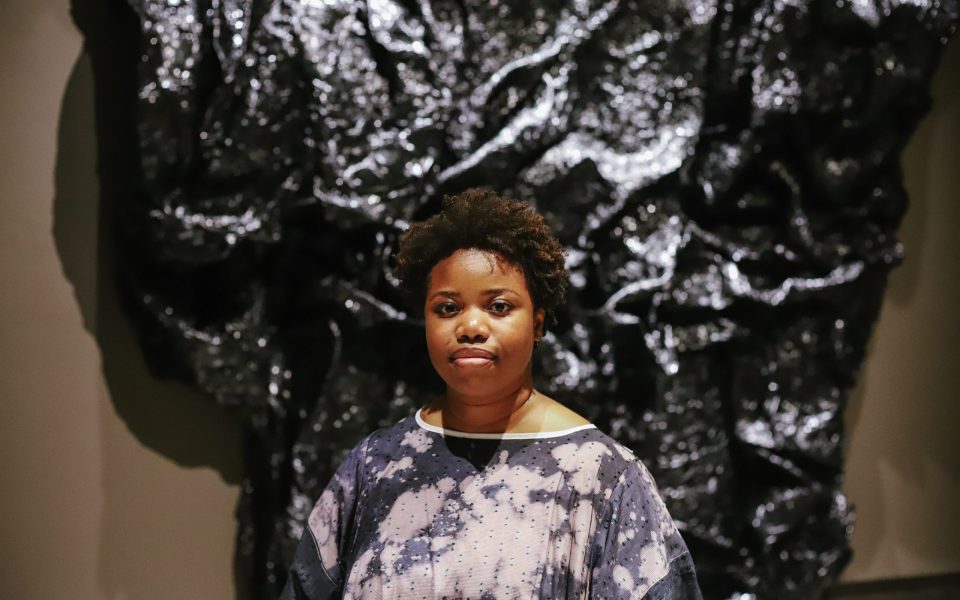Featured photo: A screengrab from a video interview with Allana Clarke on SECCA’s YouTube page.
Since mid-June, SECCA has displayed Allana Clarke’s Tender, a sculpture exhibit exploring the complex layers of Black identity, hope and history. The show, which runs through Sept. 15 is a ticketed exhibit.
On Aug. 22, curator Jared Ledesma, who works as the Curator of 20th-Century Art and Contemporary Art at SECCA, which is also known as the NC Museum of Art, Winston-Salem, will walk visitors through the exhibit on a guided tour. In the last few years, the NC Museum of Art in Raleigh and SECCA have deepened their relationship and now share curatorial staff who work across both museums. Learn more at secca.org.
Tell me about how this exhibit came together.
I worked with Allana Clarke in 2021 while I was a curator at the Akron Art Museum [in Ohio]. I had such a fantastic experience with her that when I moved on to the North Carolina Museum of Art, I contacted her almost immediately with the opportunity of a solo exhibition.

Our initial discussions for the exhibition began in December 2022. Allana and I met and discussed the show, thinking that it would be a combination of former work and brand-new work. She drafted a proposal for the exhibition which I reviewed, and from there we both sprang into action.
What are the major themes that run through the exhibit?
There are three major themes that can be pulled from the exhibition: body ownership, the slipperiness of language and resilience.
Clarke performs with hair-bonding glue to create absorbing sculptures that respond to the pressures of beauty standards within the African diaspora. Her work also challenges the negative connotations and associations surrounding natural Black hair, perpetuated by media and society. Ultimately, her work is about reclaiming control over one’s own body, free from external pressures and prejudice.
In the cocoa butter text poems, Clarke explores the slipperiness of language, particularly how words like “survive” can take on different meanings when removed from context and viewed by different communities. She emphasizes this fluidity by presenting singular word poems that highlight subtly powerful terms, such as “tender.”

Clarke’s performance and practice embody resilience and are enacted to reconcile with trauma. Her work also offers hope for a future where restrictions on beauty, especially concerning Black bodies, are a relic of the past.
How does the exhibit fit into SECCA’s larger mission?
Part of the curatorial vision at NCMA W-S [aka SECCA] is to produce bold, thought-provoking exhibitions guided and motivated by the current political and aesthetic climate. Through her performative interrogations of Black beauty standards and its associated trauma, Clarke’s work accomplishes this, especially at our fraught moment. My curatorial colleagues and I also hope to exhibit artwork that challenges artistic conventions and broadens our visitors’ definition of contemporary art. This is something that NCMA W-S (and SECCA as it has been known for several decades) has achieved in the past and will continue to do.

What is your favorite piece in the show?
That’s so hard! I really like the concrete cocoa butter poem “Did You Listen” — the way it’s displayed, where the words are separated and singled out is quite commanding and really resonates with Clarke’s aim to ask viewers to pause and reflect on the power of words.
While the large-scale, hair-bonding glue sculpture is impressive, I find myself more drawn to the intimate ones, especially “So am I.” Seeing the work at a nearly human scale creates a deeper connection between the viewer, the sculpture, and the artist — a synergy that can evoke a powerful, emotional response.
Other things on the horizon you’d like to share?
This fall at NCMA W-S we have three exciting exhibitions coming up, one that my colleague Linda Dougherty is working on featuring the work of photographer Tyler Mitchell, and two I’m organizing: Tell me if the Lovers Are Losers, featuring the expressionist paintings of John Brooks (who is a native of Kentucky, a graduate of the College of Charleston, and is now in LA), and THERE, featuring the gorgeous embroidery work of Palestinian American artist Jordan Nassar.
Join the First Amendment Society, a membership that goes directly to funding TCB‘s newsroom.
We believe that reporting can save the world.
The TCB First Amendment Society recognizes the vital role of a free, unfettered press with a bundling of local experiences designed to build community, and unique engagements with our newsroom that will help you understand, and shape, local journalism’s critical role in uplifting the people in our cities.
All revenue goes directly into the newsroom as reporters’ salaries and freelance commissions.


Leave a Reply